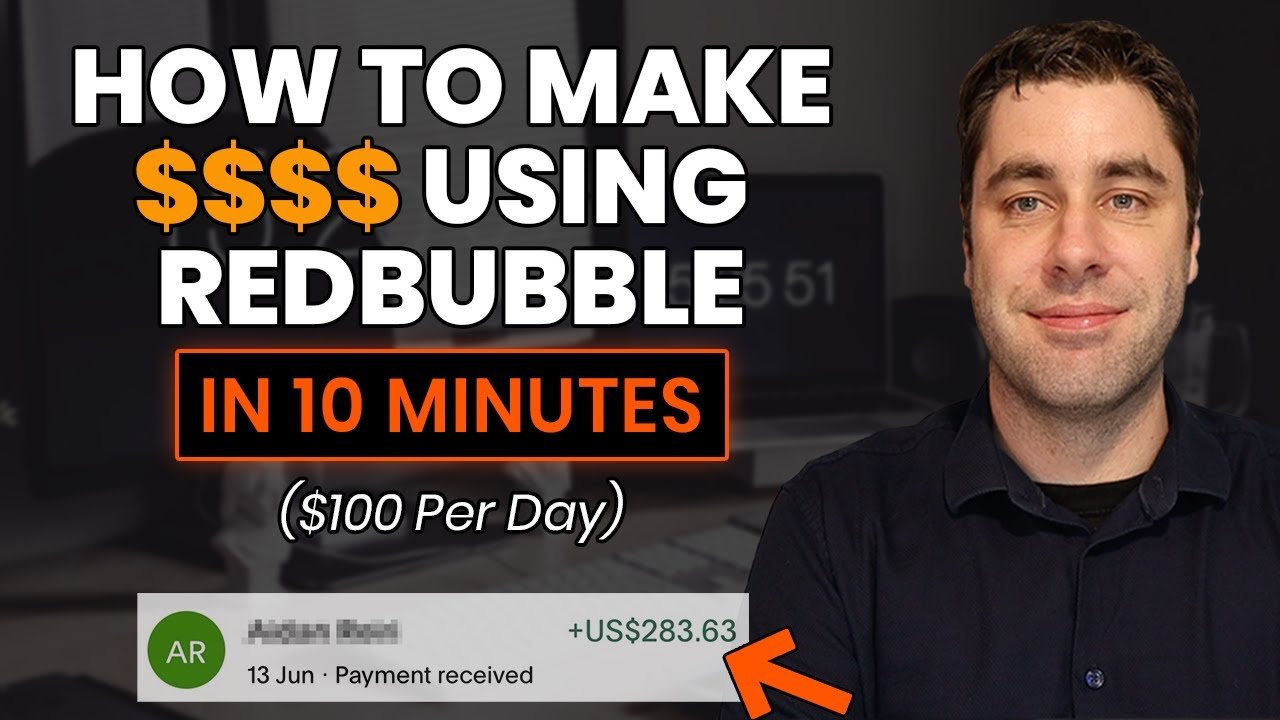In “Step-by-Step Redbubble Tutorial by Franklin Hatchett for Beginners,” you’ll discover a straightforward guide to making money online using Redbubble, a free print-on-demand platform. Franklin Hatchett’s tutorial makes it simple for beginners to start without needing a personal website, covering everything from finding trending products with Bubble Spider to creating designs via Fiverr or A.I. software, and successfully setting up a Redbubble store.
Hatchett explains how to identify popular, low-competition niches and emphasizes the importance of trends, competition, and trademark considerations. The tutorial covers creating and uploading T-shirts and stickers, setting profit margins, and setting up payments, making it easy for anyone to start selling on Redbubble. Dive into this step-by-step approach to boost your earnings and see examples like “Hot Dog Girl Summer” and “Banana Cat Meme” to inspire your store.
How to Make Money on Redbubble: A Comprehensive Guide

This image is property of i.ytimg.com.
Creating a Redbubble Account
Sign-Up Process
First things first, head over to the Redbubble website. You’ll notice a ‘Sign Up’ button right at the top. Click on it and fill in your basic details like email address and password. Alternatively, you can also sign up using your Google or Apple account for a quicker process. Once you’ve filled in your details, click the ‘Create My Account’ button. Voila! You’re in. It’s really that simple and takes just a few minutes.
Account Verification
After signing up, you will receive a verification email. Open your email inbox, find the email from Redbubble, and click the verification link. This step is crucial to ensuring that your account is secure and fully activated. If you don’t see the email, check your spam or junk folders. Once verified, you’re all set to start setting up your profile.
Basic Profile Setup
Now that your account is verified, it’s time to personalize your profile. Add a profile picture, cover image, and a short bio. This not only makes your account look professional but also helps in building trust with potential buyers. Try to be creative and let your personality shine through your profile. Don’t forget to add social links if you are active on platforms like Instagram or Facebook. This helps in promoting your store later on.
Understanding the Redbubble Platform
Overview of Redbubble
Redbubble is a print-on-demand (POD) platform where you can sell your designs on a variety of products such as t-shirts, stickers, phone cases, and more. The platform handles everything from printing to shipping, so you don’t need to worry about inventory or logistics. All you have to do is upload your designs, and Redbubble takes care of the rest.
Print-on-Demand Model
The beauty of the print-on-demand model is that you don’t need to invest in any stock upfront. When a customer purchases a product with your design, Redbubble prints the item, packages it, and ships it to the customer. You earn a commission on each sale without having to lift a finger after uploading your designs. This is why POD is a low-risk business model, especially suitable for beginners.
Key Features and Benefits
Redbubble offers several key features that make it an attractive platform for artists and designers. These include a wide variety of products to choose from, global shipping, and a user-friendly interface. Additionally, Redbubble has a large customer base, giving your designs more exposure. The platform also offers robust analytics to help you track your performance and make data-driven decisions.
Finding Trending Products and Niches
Using Bubble Spider
One of the first tools you’ll want to get familiar with is Bubble Spider. This free tool helps you find trending products and low-competition niches on Redbubble. Simply go to the Bubble Spider website and enter keywords related to your interests. The tool will show you various metrics, including trend data and competition levels. Focus on niches that are trending but have low competition to maximize your chances of success.
Analyzing Trends and Demand
Understanding current trends is crucial for your success on Redbubble. Use tools like Google Trends and social media platforms to analyze what’s currently popular. For example, keywords like “Hot Dog Girl Summer” or “Banana Cat Meme” might be trending. Look at what designs are already available in these niches and think about how you can offer something unique that stands out.
Low-Competition Niches
Finding a low-competition niche can be a game-changer. Use Bubble Spider to filter niches with lower competition but still a decent amount of search volume. For example, niches like “Spider Punk” or “Wolf with Flowers Girl” may not have a lot of designs up yet, giving you an excellent opportunity to capture the market. These niche markets often have highly passionate audiences, which can lead to consistent sales.
Creating High-Quality Designs
Hiring Designers on Fiverr
If you’re not confident in your design skills, Fiverr is a fantastic place to hire talented designers. Simply search for “t-shirt design” or “sticker design” on Fiverr, and you’ll find plenty of freelancers ready to bring your ideas to life. Make sure to review their portfolios and read customer feedback before hiring. Investing in quality designs from the get-go can significantly boost your sales.
Using AI Tools like Midjourney
AI tools like Midjourney can also help you create stunning designs without needing advanced graphic design skills. These tools offer various templates and design elements that you can customize to suit your niche. They are particularly useful for creating multiple design variations quickly, which can be handy when you’re experimenting with different products and niches.
Designing for Specific Products
Different products have different design requirements. For example, a t-shirt design might need a larger, more intricate illustration, while a sticker might benefit from a simpler, bold image. Spend some time understanding the specific design guidelines for different Redbubble products. This ensures that your designs not only look good but also print well on the products you choose to offer.

Uploading Your Designs to Redbubble
Step-by-Step Upload Guide
Uploading your designs to Redbubble is straightforward. Log in to your account and navigate to the “Add New Work” section. Click “Upload New Work” and choose the design file from your computer. Make sure your file is high resolution for the best quality print. After uploading, give your work a catchy title and description.
Setting Up Product Variations
Once your design is uploaded, you can choose which products you want to offer. Redbubble allows you to apply your design to a range of products like t-shirts, stickers, phone cases, and more. Take your time to adjust the placement and size of your design on each product. You can also choose different background colors and product types to give your customers more options.
Optimizing Product Descriptions and Tags
Product descriptions and tags are crucial for SEO. Ensure that your description includes relevant keywords that potential buyers might use to find your products. For example, if you’re selling a dog-themed sticker, use keywords like “pet,” “dog,” and “Labrador.” Also, fill out all optional sections, including categories and colors. The more detailed you are, the easier it is for customers to find your products.
Setting Your Prices and Profit Margins
Understanding Redbubble Pricing
Redbubble’s pricing model allows you to set your own profit margins. The platform gives you a base price for each product, and you can then add a markup percentage on top of this. This markup is your profit for each sale. The good news is that you have full control over how much you want to earn.
Setting Markup Percentages
A common strategy is to start with a reasonable markup percentage, usually between 20% to 30%. This ensures that your prices remain competitive while still allowing you to make a decent profit. For instance, if Redbubble’s base price for a sticker is $1, a 20% markup would mean you earn $0.20 for each sale.
Profit Calculation Examples
Let’s break this down with an example. Suppose you’re selling a t-shirt. The base price given by Redbubble is $20. If you set a markup of 30%, the selling price will be $26. The $6 difference is your profit for each t-shirt sold. Similarly, for a sticker with a base price of $1, a 20% markup will make it $1.20, giving you a $0.20 profit per sticker sold.

Setting Up Payment and Tax Information
Payment Options (PayPal, etc.)
Redbubble supports multiple payment options, including PayPal and bank transfer. To set up your payment information, go to your account settings and navigate to the payment options section. Enter your PayPal email or bank account details. Make sure the information you provide is accurate to avoid any payment issues.
Entering Tax Information
Tax information is critical to ensure you comply with legal requirements. Redbubble will guide you through the necessary steps to enter your tax information. Depending on your location, you might have to fill out forms like W-9 (for U.S. residents) or W-8BEN (for international sellers). Take your time to fill these forms correctly to avoid any hiccups later on.
Verifying Your Payment Details
After entering your payment and tax information, you may need to verify your details. Redbubble may send a small test deposit to your bank account for verification purposes. Check your account, note the test deposit amount, and enter it back into Redbubble for confirmation. This step ensures seamless payment processing for your future sales.
Marketing and Promoting Your Redbubble Store
Using Social Media
Promoting your Redbubble store on social media is a powerful way to drive traffic and sales. Platforms like Instagram, Pinterest, and Facebook are perfect for showcasing your designs. Create engaging posts and use relevant hashtags to increase visibility. Don’t just promote your products; share behind-the-scenes looks at your design process to connect with your audience on a personal level.
SEO Optimization for Your Store
Search engine optimization (SEO) is not just for websites. Ensure your Redbubble store is optimized for search engines by incorporating relevant keywords in your titles, descriptions, and tags. Use tools like Google Keyword Planner to identify high-traffic keywords related to your niche. The better your SEO, the more likely your store will appear in search results.
Leveraging Affiliate Links and Partnerships
Another effective way to boost your sales is through affiliate marketing and partnerships. Join Redbubble’s affiliate program and share your store’s affiliate link. You’ll earn a commission on any sales made through those links. Partnering with influencers or bloggers in your niche can also drive traffic to your store. Offer them samples of your products in exchange for reviews or shoutouts.
Analyzing Sales and Performance
Using Redbubble Analytics
Redbubble provides built-in analytics to help you track your sales and performance. These analytics give you insights into which designs and products are performing well, where your traffic is coming from, and your overall sales numbers. Regularly check these metrics to understand what’s working and where you can improve.
Understanding Sales Data
Sales data is more than just numbers. It tells you what your customers like and how they find your products. Pay attention to metrics like conversion rates, average order value, and customer feedback. If certain designs are selling more than others, create more products in that style or theme. Conversely, consider discontinuing designs that aren’t performing well.
Adjusting Strategies Based on Performance
Based on your sales data, you might need to adjust your strategies. If a particular niche is performing well, double down on it by creating more designs. If your social media campaigns are not driving enough traffic, it might be time to try different platforms or strategies. Regularly reviewing and tweaking your approach ensures that you’re always optimizing for better performance.
Conclusion
Recap of Key Points
To recap, making money on Redbubble involves several key steps: creating a Redbubble account, finding trending and low-competition niches using tools like Bubble Spider, creating high-quality designs, uploading those designs, setting competitive prices, optimizing your store for SEO, and effectively marketing your store through social media and partnerships. Additionally, consistently analyzing your performance helps you refine your strategies for continued success.
Additional Resources
If you want to delve deeper, there are plenty of resources available. You can find helpful tutorials on YouTube, read blogs about print-on-demand strategies, or join online communities and forums where Redbubble sellers share tips and advice. Continuous learning can provide new insights and techniques to enhance your store’s profitability.
Encouragement to Get Started
Starting your own Redbubble store can be an exciting and profitable venture. The best part? You don’t need any prior experience or a personal website to get started. Follow the steps outlined in this guide, be creative with your designs, and don’t be afraid to experiment with different niches. The world of print-on-demand is vast and full of opportunities. So, what are you waiting for? Dive in and start making money on Redbubble today!